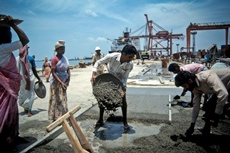UN summit adopts 15-year blueprint for sustainable development
26 Sep 2015
World leaders meeting at the United Nations headquarters in New York on Friday unanimously approved an ambitious 15-year blueprint to eradicate extreme poverty, combat climate change and address more than a dozen other major global issues.
 Presidents, prime ministers and diplomats from the UN's 193 members stood and applauded loudly after General Assembly president Mogens Lykketoft gavelled approval of the development roadmap.
Presidents, prime ministers and diplomats from the UN's 193 members stood and applauded loudly after General Assembly president Mogens Lykketoft gavelled approval of the development roadmap.
With more than 150 heads of state and government in attendance, the summit has ushered in a new era in development, one that considers social, economic and environmental dimensions as elements of a coherent whole, working for the good of people and planet, with poverty eradication at the core.
The new agenda, built around 17 interconnected Sustainable Development Goals (SDGs) that were elaborated in a three–year–long transparent, participatory process, will chart a course for the sustainable development of the world for the next 15 years.
Discussions on how to implement the new goals - expected to cost between $3.5 trillion and $5 trillion every year until 2030 - is expected to dominate the three-day summit that will include speeches by US President Barack Obama, China's President Xi Jinping and the leaders of Egypt, India, Iran, Germany, Britain and France.
UN secretary-general Ban Ki-moon told the General Assembly that the test will be implementation, calling for action from all people, everywhere, and high-level political commitment.
''The 2030 agenda for sustainable development is built on the pledge to 'leave no one behind,' and sustainable transportation is absolutely essential to make sure this pledge is fulfilled,'' said Wu Hongbo, under-secretary-general for economic and social affairs of the United Nations.
''Transport sits at the intersection of many SDGs - on health, sustainable cities, climate, economic growth - and with its expertise the Secretary-General's high-level advisory group can lead the way to innovative solutions addressing these integrated issues.''
A recent assessment of the SDGs commissioned by the high-level advisory group found that sustainable transport will be central to the implementation of many of the SDGs as transport makes cities liveable and functional, connects rural populations to markets, brings people to their jobs, and enables global trade and economic growth.
SDG 11 on sustainable cities calls for increased access to safe, affordable and sustainable public transportation; and SDG 3 on health includes a target on enhanced road safety. In addition to these explicit targets, sustainable transport is also essential to many other SDGs, including on women's empowerment (SDG 5), economic growth (SDG 8), resilient Infrastructure (SDG 9), and climate change (SDG 13).
The Addis Ababa action agenda on financing for development also stressed the role of transport, calling for investments to bridge infrastructure gaps, including in transport.
''Investing in sustainable transport is one of the most effective and powerful tools we have today to advance towards more inclusive societies,'' expressed Santiago Mayor Carolina Toha, co-chair of the High-Level Advisory Group.
''Public transport is used by most people in the world and is particularly important in fast-growing cities in the developing world. We have an historic opportunity to facilitate adequate policies that will avoid unsustainable practices as cities grow, strengthening better services and incentivizing the use of clean means of transport.''
The High-Level Advisory Group will next meet in Paris in December 2015, on the margins of COP 21. The Group will discuss strategies for increasing the positive impact of sustainable transport measures on climate change mitigation.
The High-Level Advisory Group was established in 2014 with a three year mandate to develop policy recommendations and to encourage multi-stakeholder partnerships to advance sustainable transport at the local, national, regional and global levels. The group represents all sectors and modes of transport.
The agenda "embodies the aspirations of people everywhere for lives of peace, security and dignity on a healthy planet," Ban said. The goals "are a to-do list for people and planet, and a blueprint for success."
The non-binding goals will succeed the eight Millennium Development Goals adopted by world leaders 15 years ago.
Despite significant progress, however, the only one achieved before this year was halving the number of people living in extreme poverty, due primarily to economic growth in China.
The broad new goals include ensuring "healthy lives," quality education for all, clean water, sanitation and reliable modern energy - and achieving gender equality, making cities safe, reducing inequality within and among countries, and promoting economic growth.
Critics say they are too broad, lack accountability and will lead to disenchantment among those in the world most in need of hope.
Supporters say there is no choice but to go big in a world of expanding population, growing inequality, dwindling resources and the existential threat from global warming.






















